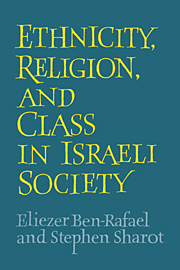Book contents
- Frontmatter
- Contents
- Acknowledgments
- I Theoretical and empirical background
- 1 Ethnicity and society
- 2 Divisions in Israeli society
- 3 Theoretical perspectives in Israeli sociology
- 4 The sample, its background, and its setting
- II Social patterns and behavior
- III Identities and images
- IV The impact of stratification
- V Social cleavages: an overview of Israeli society and some theoretical implications
- Appendix A The sample
- Appendix B Deprivation index
- Appendix C Indexes of ethnic identification
- Glossary
- Notes
- References
- Index
1 - Ethnicity and society
Published online by Cambridge University Press: 12 September 2009
- Frontmatter
- Contents
- Acknowledgments
- I Theoretical and empirical background
- 1 Ethnicity and society
- 2 Divisions in Israeli society
- 3 Theoretical perspectives in Israeli sociology
- 4 The sample, its background, and its setting
- II Social patterns and behavior
- III Identities and images
- IV The impact of stratification
- V Social cleavages: an overview of Israeli society and some theoretical implications
- Appendix A The sample
- Appendix B Deprivation index
- Appendix C Indexes of ethnic identification
- Glossary
- Notes
- References
- Index
Summary
Many social scientists have perceived a “resurgence” or “revival” of ethnicity in recent decades in many societies. The analysis of the reassertion of ethnic identities, the emergence and growth of ethnic movements, and the pervasiveness of ethnic conflicts has been one of the most important growth areas of sociology in the last two decades. It is admitted that sociologists and political scientists in the 1950s and early 1960s had assumed that ethnicity was declining in importance, and that it would continue to decline in the future. Western states had been held up as “nation states” that had succeeded over the centuries to assimilate and amalgamate diverse peoples, and many expected that the newly independent states in Africa and Asia would follow suit. Ethnicity was often associated with traditional societies, and it was expected that the process of modernization would weaken such ascription-based groups.
The growth of ethnicity and ethnic conflict has been analyzed as a universal or world-wide phenomenon. Not only have “tribal” or ethnic differences posed acute obstacles to the “nation-building” of newly independent states, but ethnic groups have appeared to endanger what had been considered the accomplished unity of European states. In multinational states, such as the Soviet Union and Yugoslavia, ethnic divisions and conflicts have perhaps only become more manifest and politicized, but indigenous ethnic movements have also appeared in countries, such as Britain and France, which had been considered unified nations.
- Type
- Chapter
- Information
- Ethnicity, Religion and Class in Israeli Society , pp. 3 - 23Publisher: Cambridge University PressPrint publication year: 1991

